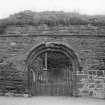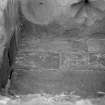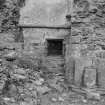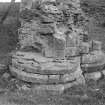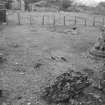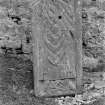Pricing Change
New pricing for orders of material from this site will come into place shortly. Charges for supply of digital images, digitisation on demand, prints and licensing will be altered.
Field Visit
Date 9 June 1925
Event ID 1099083
Category Recording
Type Field Visit
Permalink http://canmore.org.uk/event/1099083
Lindores Abbey.
The remains of Lindores or "Lundors" Abbey stand overlooking the estuary of the Tay on a sheltered and level site less than half a mile east of Newburgh. On north and east flows a little stream, Pow of Lindores, which formed the eastern boundary of the Abbey lands between Lindores Loch and the Tay. The ruins are fragmentary, the buildings having been freely plundered for ashlar. But, although no part of the Abbey has been left entire, the ground plan has been refined by excavations carried out about the middle of last century.
Founded in the late 12th century by David, Earl of Huntingdon, grandson of David I, and munificently endowed by him and by subsequent benefactors, Lindores was an important Tironensian house, colonised from Kelso. The first abbot, Guido, had been a monk of that house; he is said to have "built the place from the foundations as well as the greater part of the outbuildings proper to it (officinas competentes)” (1), monks having been sent to him from Kelso for the work (2). While the extent of Guido's work is conjectural, church and cloister may safely be ascribed to him, as these parts bear traces of Transitional detail. The masonry is executed mainly in red freestone from the quarry of "Hyrneside" or" Irnsyde," which lay about a mile east from the Abbey and was the property of the founder, who granted to his monks of Lindores the right to take as much stone as they required (3). The extent of the precinct cannot be determined. The Newburgh-Newport road cuts through the site, the church and cloister lying to the north of it and fragments of three other buildings in a meadow to the south.
The lay-out of the cloister is normal. On the north is the church, on the east are a parlour and slype (Fig. 352), the chapter-house, and a long hall. The last may have been the warming-house; within it, at the northern end, is the day-stair to the dorter on the upper floor of the range. The dorter communicated with the church by means of a newel-stair-the night stair-situated in the south-west angle of the south transept. On the western side of the cloister were the store-houses or cellarium, and on the southern, facing the church, was the frater, its undercroft having at the eastern end a passage running southward and, at the other end, in line with the western range, a chamber that may have been the kitchen. At the south-west corner of the site facing the road is a gateway (Fig. 349), which was attached to some form of gatehouse. In addition to the inner cloister, there has been at least one other enclosure, to the south of the road, where the most considerable fragment of building has been part of a barn or granary.
[see RCAHMS 1933, 215-220, for a full architectural description]
HISTORICAL NOTE. Guido is stated to have died on 17th June 1219 after nearly twenty-eight years as abbot (1). This would date the foundation to about 1191, but, in an earlier passage of the same record, Earl David is declared to have founded the monastery in 1178 (7). The latter year is also given in an MS. of the earlier work of John of Fordun (8). An immediately succeeding entry in the same work says that Earl David founded Lindores "a new" (a novo) (9). This, taken along with the statement that Guido built "from the foundations," suggests that there may have been a house at Lindores before the arrival of Guido. If so, it would be a priory and the convent founded by Earl David in 1178, which, about 1191, was amplified into an abbey, as appears to have been the course of events at Dunfermline. In that case Guido's buildings would have to be new ones on a grander scale and so could be said to have been erected "from the foundations." Such an explanation would account for the discrepancy in dates. Guido at his death left behind him twenty-six monks (1). In 1289 the abbot and convent were granted leave to wear caps suitable to their order on certain festivals and in processions, because Scotland was a cold country and the monks had suffered much from cold in the head (10). Another source of annoyance was the proximity of wild (sylvestrium) Scots, so that early in the 15th century the buildings were said to be ruined and the rents diminished, on which account the Abbey received a grant in 1414 of the parish church of Creich (11). In September 1543 Sir Ralph Sadler, the English ambassador, reported how a "company of good Christians, as they call them here ... has sacked Landorse Abbey” (12). In 1559 the place was "reformed" by overthrowing the altars and burning images, vestments, and mass-books (13).
A charter of 1457 gives, in addition to the Abbot, the names of 24 monks "chapterly assembled” (14).
A lease of 1532, granted by the abbot and convent assembled in chapter, is signed by the abbot, sub-prior, and 24 monks (15), the establishment being thus of the same number as at the death of the first abbot in 1219. Another lease of 1546 is signed by the abbot, sub-prior, and 18 monks (16).
RCAHMS 1933, visited 21 July 1925.
(1) Scotichr., lib. IX, cap. xxvii. (2) Chartulary of Lindores Abbey (S.H.S.), p. 284. (3) Ibid., No. vii. (4) “They had ancientlie in this abbey 4 great bells, Michael, and Raphael, Mary bell and Gabrielle, of which Mary bell was of silver, the gift of ther first founder." Balfour MS. in the National Library quoted in Lindores Abbey, &c., by Alexander Laing, F.S.A. Scot., p.132. (5) Proc. Soc. Ant. Scot., ix (1870-2), p. 209. (6) Henry, the eldest, who died young is recorded to have been buried there. Fordun, Gesta Annalia, xxx. (7) Scotichr., VIII, xxv. (8) Fordun, Gesta Annalia, xxix. (9) Ibid., xxx. (10) Theiner, Vetera Monumenta, No. cccx. (11) Papal Registers, i, p. 601. (12) Letters and Papers, For. and Dom., Henry VIII, xviii, Part ii, No. 128. (13) Knox's letter in Calderwood's History of the Kirk of Scotland (Wodrow Socy.), i, p. 470. (14) Lindores Abbey, p. 479. (15) The Stirlings of Keir, Sir W. Fraser, pp. 346-9. (16) Lindores Abbey, p. 430. Cf. also Eccles. Arch., ii, p. 217.











